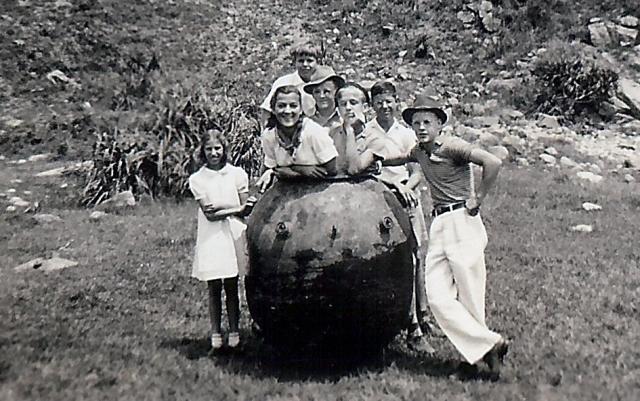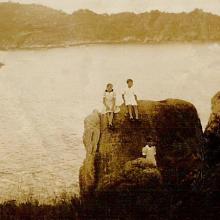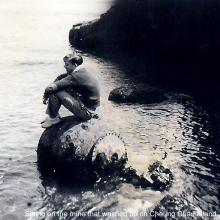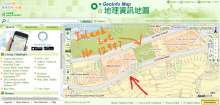Where: Cheung Chau Island.
When: No date is given, but it should be 1940 or 1941.
Who: This photo is courtesy of Laura Darnell (née Ziegler), who writes:
My sister Eunice is on the left, Laurence Z. on top and Everett Z. second from the right.
I'll call them the luckiest children on Cheung Chau, if not the whole of Hong Kong, because of what they're leaning on...
What: A Royal Navy mine, filled with enough explosives to sink a ship!
The Navy had laid defensive minefields around the entrances to Hong Kong harbour. Unfortunately, stormy weather could break the mines loose from their anchors, and send them onto the beaches at Cheung Chau.
Newspaper reports from the time show it wasn't an isolated incident, and give an idea of the destructive power of the mines:
4th March 1940: A terrific explosion of a mine at the south-east corner of Cheung Island [sic.] occurred about 1.45 o'clock yesterday morning, rudely awakening from their slumber the population of 10,000 and many more people as far away as Kowloon and Hongkong.
The explosion occurred on the rocks below no. 11, Cheung Chau, and was of such force that pieces of shrapnel were found by people throughout yesterday a good distance inland and huge pieces of rock were hurled over 100 feet into the air, some to land on the hillside.
Hongkong Daily Press, page 1.
There were another two explosions that night, thought to be mines hitting nearby islands. Within weeks there were even more:
26th March, 1940: The revelation that no less than seven mines exploded on Good Friday [the 22nd March] alone has been made as a result of enquiries by "Telegraph" reporters.
All of these explosions occurred in the vicinity of Cheung Chau Island, fortunately without causing any danger or loss of life.
At least two other explosions occurred on Saturday and one on Sunday.
The breaking away of these mines is attributed to heavy seas which have been experienced outside the sheltered harbour limits lately.
It is emphasised in this connection that the prevailing currents carry the mines in the general direction of Cheung Chau island.
Hongkong Telegraph, page 1.
The most lethal explosion happened the following year:
10th July, 1941: Some 30 junks and sampans were destroyed on Monday morning when two of the craft were struck by drifting mines off Cheung Chau Island, according to a belated report received by the headquarters of the Hong Kong Chinese Fishermen's Union last night.
Over 100 were killed and injured. Many corpses floating off the Island have since been picked up.
China Mail, page 1.
Note that the mine in the photo above isn't on the sand, which means it's been rolled up the beach to get it into a better place for a photo. Does it mean that the mine had already been made safe by bomb disposal experts, and the children are just posing by the empty casing?
Not according to Laura:
The boys took it apart and there is a nice story that goes with that. It was full of nitroglycerin!
Amazingly, they all lived to tell the tale.
Regards, David





Comments
Mines on beach at Cheung Chau Island 1940
Before my brother, Howard Ziegler died, he sent a priceless email telling about this mine incident. Portions of the email are below:
"I was in on the mine incident. We could have been killed. The mine had floated ashore at the bottom of the hill below our house. I think Everett ((brother in the picture)) and a couple of other guys and I pulled and rolled the mine up on shore. We unbolted the lid and found a big round cake of pink explosive. We cut all the wires away and pulled the cake out and rolled it into shallow water and put heavy rocks on it. We went back the next day to see what I believe was TNT, and it was gone. There were a few unexploded horns on the out side, yet-each of these could blow up too-but they didn't. I have several pictures of the mine shell with kids in it and standing around it. The Lord saved all of us. The British Navy really got mad at us!"
There are also pictures of the shrapnel collected after a bomb exploded. Another picture shows Howard sitting on a mine washed up at the shoreline.
Does anyone know the other children shown in this picture?
Laura Ziegler Darnell
And the not so lucky...
Laura, you and your pals must have used up 8 of your 9 lives that day!
I was immediately reminded of a similar incident off the NW coast of Ireland that still lives on in local memory.
On this occasion it must have been a huge mine at 8ft diameter, (if that dimension is accurate)
A short extract from the Irish Government seanad report below:Seanad Éireann - Volume 189 - 23 April, 2008
Mine Disaster.
As many of the battles of the Second World War were fought at sea, an important feature of naval policy was the laying of sea mines. The sea current often altered the direction of these floating mines away from intended targets and in to unintended areas. One such mine was washed ashore in Ballymanus, County Donegal.
On the evening of 10 May 1943, word went around Ballymanus that a curious and strange looking object was floating in the water close to the coast. Some 23 young people went to investigate the object which turned out to be a mine approximately 8 ft. high and with some of its spikes bent owing to being crushed against the waves and rocks. Some of the people gathered on the shore tied a rope around the already bent spikes and an attempt was made to haul the object closer to the shore. The mine subsequently exploded with a horrifying bang which could be heard up to 40 miles away. It was only when the dust settled that the true extent of the incident became known to all. It was a horrifying experience. Many were killed instantly and others died later in hospital. Four people survived the explosion. However, 19 men ranging in age from 14 years to 34 years lost their lives.
Anyway thank God you all lived to tell the tale!
These floating mines must have been a right menace for many years after the war I imagine.
More about the Cheung Chau mines
Laura notes that her original memory that the mine was filled with nitroglycerin was wrong, and that her brother's email said it contained a cake of explosive he thought was TNT.
She also sent copies of the photos she mentioned above. The first shows her brother Howard, "sitting on the mine that washed up on the beach below our house on Cheung Chau Island.":
And two of "Shrapnel picked up by the Ziegler children on the beach on Cheung Chau Island.":
Finally she sent a link to Don Ady's memories of the mines on Cheung Chau.
Regards, David
Ferry struck by mine near Gal Ye Chau in 1957 ( or 1958)
It's hard to recall the exact year, in 1957 or 58, a ferry of the Yumati Co, run between Hong Kong and Peng Chau got struck by a WWll mine in the rear which housed the toilet, at the island vicinity of Gal Ye Chau.
The ferry suffered minor damages at the rear and listing, but was able to make to the closest landing. Luckily no one was in the toilet at that time.
A friend of mine was on the ferry. He felt so excited like hero overcoming a war episode.
Thanks Heaven!!
Tung
re: Ferry struck by mine
Lucky that no-one was harmed. Was that the last of the wartime mines, or were there any further incidents after that?
Regards, David
Cheung Chau Mines
I was looking through my baby book and found a story written by my dad about the mines exploding against the Cheung Chau rocks:
"One night on Cheung Chau, when the British marine mines were exploding against the rocks in a "blow" from the S. China Sea, Grace (my mother) was hysterical and wept. Little Scott (me) pulled up, sleepy eyed in his crib, and said, "Don't be 'fraid Mommie; I'll help you." It changed tears of fright into tears of joy and laugher."
I would have been about 3 years, 3 months old at the time. I do not remember making such a bold statement; however, I do remember the terrific explosion and the darkness. This is one of the few things I recall from my early days in Hong Kong.
Scott
Possible Location of the Ziegler Kids' Mine adventure
I have studied a particular stretch of coast off the #29 House area and tried to identify the exact location of the Ziegler Kids' Mine based on the two photos given by Laura. First is the Happy Ziegler Seven and the Mine on the shore, and the next photo having the Amazing Howard Sitting on the Stray Mine in the shallow water.
The first photo would have the photographer who was standing on some kind of rock or rock table near the shore, looking back at the immediate foothill. The land they were standing on was quite dry, with grass and other plants all around. This was a very unique patch of shore line quite different from the rocky or pebbled nature. It seemed to be an area well-protected from the wavy seawater most of the year. Yet it allowed the Mine be able to slip in or roll in, by some added help.
The second photo of the Mine with Howard does reveal the nearby details of the landscape --- couples of stone head in water by the headland of their house. The background seemed to be the foot of the hill where the Laura's Mystery Rock Group situated.
Since the Mine was made to float unless being anchored to stay below some water level, it was not too heavy for people to roll the mine around in water if the anchor was broken off. The tides already transported this mine to the shallow water and the mechanical inside the mine must got damaged due to the constant pounding against the rocks in the area, most likely a barrier where the photographer took the stand.
A place that well fit the criteria is the tiny delta formed with the open ravine just a bit north of the Laura's Mystery Rock group. This part of the hill slope would have been their daily game ground. ( The ravine also has a secret tunnel as I had mentioned in one of my comments ) Although the delta is right by the sea, it is well separated from the wavy sea with a natural dike of coastal rock formation. A study of this dike from the satellite photo shows lots of wave foams evidence on the seawater side but none on the delta. So this dike seemed to be the ' before and after' location of the adventure of Ziegler Kids' Madness Mine Event.
Check it out yourself. It's fun to know!
Tung
PS By the way, the Royal Navy always had one or two Minesweepers mooring in the Cheung Chau harbour in the 1950s that attracted lots of boys to see them out of curiosity. We never thought of the importance of their service back then. We just enjoyed watching the advance equipment of a military vessel or trying to learn a few words of english from the crew. Much later a young man from the CLCY village joined the RN Minesweeper and he later settled down in UK.